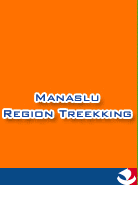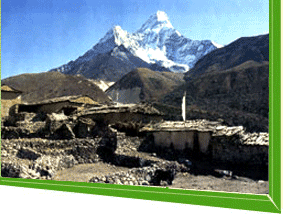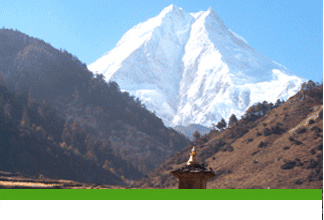|
| |
|
| |
| Travel Discussion |
Our online travel community,asking questions and sharing advice
More  |
|
| |
|
|
| Around Manaslu |
 |
|
21 Days of trekking
maximum elevation 5100 metres (16,400 feet)
This trek was officially opened to tourists in 1991, but mountaineering expeditions have long had access to the area. In 1950 a party led by H W Tilman trekked from Thonje to Bimtang and Colonel Jimmy Roberts crossed the Larkya La looking for an interesting mountain to climb. Manaslu (8156 metres) was attempted by Japanese expeditions every year from 1952 until 1956, when the first ascent was made. Having become known as a "Japanese mountain", much of the information about the area was available only in Japanese. The Japanese continued to dominate the climbing scene on Manaslu until 1971.
A few trekkers, including the peripatetic Hugh Swift, managed to obtain trekking permits for the region, but otherwise this trek has always been the domain of the mountaineering expedition.
Though the Larkya La is not a difficult pass, the trek is harder than most in Nepal. In many places the walls of the Buri Gandaki Valley are perpendicular, so you cannot walk along the bottom of the valley. There is a huge amount of wasted climbing involved during the first part of the trek as you climb up and down over ridges or onto shelves to bypass cliffs. The trail is rough and steep and it often literally hangs on a bluff high above the river. Don"t read any further if you have the slightest tendency towards acrophobia. The trek is remote and has no rescue facilities or opportunities to bail out if you are tired. There is only one facility that might conceivably be called a trekkers" hotel, and as late as AS 1992 there was not a single English signboard between Arughat and Tilje.
The trek is geographically spectacular and culturally fascinating. The Tibetans of the upper Buri Gandaki, a region known as Nupri ("the western mountains"), are direct descendants of Tibetan immigrants. Their speech, dress and customs are almost exclusively Tibetan. There is still continuous trade between Nupri and Tibet; Chinese cigarettes, for example, are found more frequently than Nepalese cigarettes. The mountain views in Nupri are sensational, and the Larkya La is one of the most dramatic Himalayan pass crossings.
|
|
Days |
Itinaries |
| Day 01 |
Kathmandu to Dhading to Kafalpani |
| Day 02 |
Kafalpani to Arughat |
| Day 03 |
Arughat to Sati Khola |
| Day 04 |
Sati Khola to Labu Besi |
| Day 05 |
Labu Besi to Doban |
| Day 06 |
Doban to Jagat |
| Day 07 |
Jagat to Serson |
| Day 08 |
Serson to Deng |
| Day 09 |
Deng to Ghap |
| Day 10 |
Ghap to Namrung |
| Day 11 |
Namrung to Shya |
| Day 12 |
Shya to Sama Gompa |
| Day 13 |
Sama Gompa to Samdo |
| Day 14 |
Samdo to Larkya Rest House |
| Day 15 |
Larkya Rest House to Bimtang |
| Day 16 |
Bimtang to Gho |
| Day 17 |
Gho to Dharapani |
| Day 18 |
Dharapani to Syange |
| Day 19 |
Syange to Bhulbule |
| Day 20 |
Bhulbule to Besi Sahar |
| Day 21 |
Drive Besi Sahar to Kathmandu |
 |
Central Nepal Trekking |
 |
|
|
Trekking Agents | Travel Agents in Nepal | Hotel Booking in Nepal | Airline Reservation of Nepal
|
|
|





